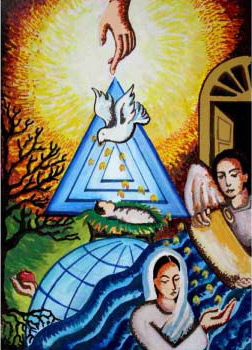Top Qs
Timeline
Chat
Perspective
Season of Annunciation
Syriac Christian liturgical season beginning in December From Wikipedia, the free encyclopedia
Remove ads
The Season of Annunciation or Season of Announcements (Syriac: ܫܒܘܥܐ ܕܣܒܪܐ),[1] also known by various Syriac transliterations such as Subara, Subbara, or Suboro (Syriac: ܣܘܒܪܐ)[2], is a liturgical season in Syriac Christianity. The name of the season is in reference to the Annunciation to the Blessed Virgin Mary,[3] the announcement by the Archangel Gabriel to the Blessed Virgin Mary, that she would conceive and bear a son through a virgin birth and become the mother of Jesus Christ.
The Period of Annunciation is present in both the East and West Syriac rites, covering the Sundays before Christmas.[4] In the East Syriac tradition, the liturgical year starts with the Period of Annunciation, and is equivalent to the season of Advent in the Western liturgical tradition. Like Advent, it is a time for the celebration of the Nativity of Jesus. But unlike Advent, the whole season is a celebration of the Nativity, while in Advent the first 24 days are a preparation for the Nativity on 25 December.
Historically, the Annunciation season in the Syro-Malabar Church came to an end in early January with the feast of Epiphany (Pindikuthi Perunnal) which was the more celebrated feast. But by the 20th century, due to influence of the Western tradition and the secular world, Christmas day (December 25) became the focal point of the season.
Remove ads
East Syriac Rite
Summarize
Perspective
In the East Syriac Rite, the Season of Annunciation, like Advent in the Roman Rite, marks the start of the liturgical year,[1] and begins on the Sunday that falls between November 27 and December 3 inclusive.[5] The season extends past Advent to also include Christmastide.[6][7] However, the present-day liturgical calendar of the Syro-Malabar Catholic Church (one of the churches that uses the East Syriac Rite) regards "Annunciation" and "Nativity" as separate seasons, with the Season of Annunciation ending prior to Christmas.[8] This is believed to be due to monastic influences,[1] and the practice is known as Irupathanchu Nombu;[9] in 1971, the liturgy for Subara was revised in Malayalam by the Syro-Malabar Central Liturgical Committee.[10] The church considers the Feast of the Annunciation as a liturgical holiday.[11]
In the Assyrian Church of the East, on the second Sunday of the season, the congregation will hear Gabriel's Annunciation to the Virgin Mary, followed by gospels the two Sundays after telling the mission of John the Baptist and the proclamation to Saint Joseph.[1] The season closes with the Feast of the Annunciation, and lasts about seven weeks.[12]
A separate commemoration of Subbara was added in the rite of the Chaldean Catholic Church.[4] For the church, the season is composed of four weeks and usually begins on a Sunday (either December 1st or the first Sunday before).[13]
Remove ads
West Syriac Rite
Summarize
Perspective
Churches that follow the West Syriac Rite call this period the Season of Annunciation (as with the Syro-Malankara Catholic Church)[14] or the Season of Announcements (as with the Maronite Church).[15] In this rite, the season begins six Sundays before Christmas,[5] making it coterminous with Advent in the Ambrosian Rite.
In the Syriac Orthodox and Malankara Orthodox Syrian Churches, the Suboro is considered one of the most important feasts in the liturgy; the Holy Qurobo is required for recital even if the Feast of the Annunciation falls on Good Friday, where it would otherwise be prohibited.[16][17]
Assyrian tradition
Assyrians in the SOC (namely from Tur Abdin) maintain unique traditions in honor of the season of Suboro. This tradition, also known as Suboro, takes place annually on March 25th.[4] A cultural/culinary tradition involves kneading unleavened dough and sprinkling grains on top; the daughter of the family then puts white and red yarn in the shape of the Cross on the dough[18] before walking around town.[3] During the making of the dough, families will also sing a hymn, The Bread of Life is Mine.[19] All the available grains in the house will be added to the dough when cooking.[20] The dough is then taken to the roof of the house and left to sit while hymns are sung; after church service, the bread is placed under the Bible and then served to the congregation.
The white and red yarn are also used to create wristbands, representing the interwined nature of the humanity (red) and divine resurrection (white) of Christ.[21][20] The wristbands by themselves represent the appearance of the Archangel Gabriel to the Virgin Mary,[22] and have theological significance in the relationship between Dyophysitism and Monophysitism.[23] Some bracelets also include black yarn, which can represent either the death of Christ or combine with the other colors to represent the Holy Spirit.[19][24] The wristbands are worn until Easter, but they may also be worn until the Christmas holiday. Sometimes, the wristbands are burned under a pot of rice pudding.[20]
Suboro is additionally practiced by Yazidis and the Mhallami,[25] an Arabic-speaking ethnic group theorized to have Assyrian origins; the Mhallami create blue and white bracelets called Basımbar.[21][20] Another tradition from the Balkans, known as Martenitsa, is similar to Suboro.
Remove ads
See also
References
Bibliography
Wikiwand - on
Seamless Wikipedia browsing. On steroids.
Remove ads
